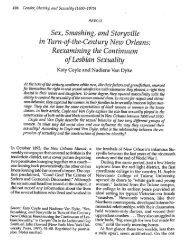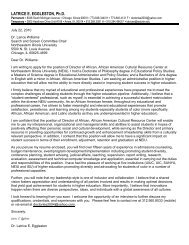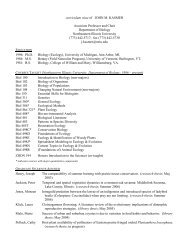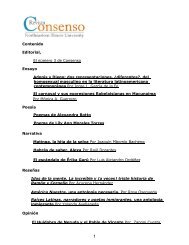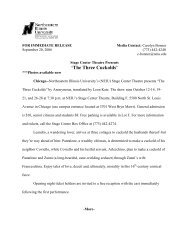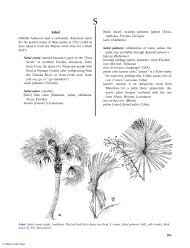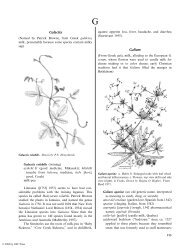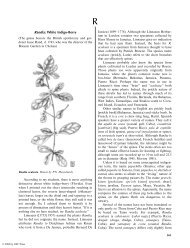Herba Cana - Northeastern Illinois University
Herba Cana - Northeastern Illinois University
Herba Cana - Northeastern Illinois University
Create successful ePaper yourself
Turn your PDF publications into a flip-book with our unique Google optimized e-Paper software.
© 2004 by CRC Press<br />
The Ethnobotany 541<br />
laitue blanc (white lettuce, Quebec); weisser Lattich<br />
(white lettuce, German); white lettuce<br />
[ivy, joy] leaf<br />
lion’s foot (used for a Helleborus, Ranunculaceae,<br />
by Turner in 1538; and for Alchemilla, Rosaceae,<br />
by 1610; later applied to other plants); ped d’leon<br />
(lion’s foot, French)<br />
milkweed (usually applied to Asclepias, but also to<br />
others with white latex)<br />
Two of the Prenanthes that Linnaeus ([1753] 1957)<br />
knew were from the New World, and the other five<br />
were from Europe and Siberia. However, it was not<br />
until 1814, when Frederick Pursh published his Flora<br />
America Septentrionale, that P. serpentaria was added<br />
to the list. Now there are 30 species known from the<br />
north temperate region, and the European plants have<br />
been reduced to a single species (Mabberley 1997).<br />
This was one of the many plants used by the<br />
indigenous tribes to relieve the bites of snakes and<br />
other venomous animals. There are many more<br />
poisonous snake species in eastern North America<br />
than in Europe, and the settlers were quick to rely on<br />
the local remedies for these problems. Accounts are<br />
common in the literature of the time of a person being<br />
bitten by a reptile and recovering after chewing,<br />
ingesting, and/or applying a poultice of some plant.<br />
Writing in 1728, William Byrd gave a typical<br />
account of the time. Not only were his observations<br />
dubious, but he also clearly had no regard for the<br />
safety of his dogs. He wrote: ‘‘The rattle-snake, has an<br />
utter antipathy to this plant, insomuch that if you<br />
smear your hands with they juice of it, you may handle<br />
the viper safely. Thus much I can say of my own<br />
experience, that once in July, when these snakes are in<br />
their greatest vigor, I besmear’d a dog’s nose with the<br />
powder of this root, and made him trample on a large<br />
snake several times, which, however, was so far from<br />
biting him, that it perfectly sicken’d at the dog’s<br />
approach, and turn’d its head away from him with<br />
the utmost aversion’’ (Coffey 1993).<br />
James Adair listed several snakebite plants, including<br />
P. serpentaria, in a book about his trading<br />
among the Creeks along the Mississippi River in 1775.<br />
Prince Maximilian listed as a remedy a plant called<br />
‘‘lion’s heart’’ among the Delaware in the 1830s (Vogel<br />
1970).<br />
In the eastern states, several tribes used Prenanthes<br />
as a snakebite remedy. At least P. alba, P. altissima, P.<br />
aspera, P. serpentaria, andP. trifoliata were utilized<br />
(Moreman 1998). These all went under the name<br />
‘‘snakeroot,’’ ‘‘lion’s foot,’’ or ‘‘gall of the earth.’’<br />
<strong>Northeastern</strong> tribes certainly applied P. alba, and<br />
there are records of both the Iroquois and Ojibwa<br />
using it on snakebite (Densmore 1928, Moerman<br />
1998). The Iroquois also used P. altissima and P.<br />
trifoliata (Moerman 1998).<br />
However, indigenous people did not confine the<br />
plant to those uses. In the south, the Choctaw used P.<br />
virgata (reported as Nabalus asper, and P. aspera,<br />
corrected by Joanne Birch) as an anodyne and as a<br />
diuretic, and for other problems (Campbell 1951). The<br />
Cherokee used both P. serpentaria and P. trifoliata<br />
roots in stomachache medicine (Hamel and Chiltoskey<br />
1975). The Cherokee also cooked and ate the leaves of<br />
these two herbs.<br />
Porcher (1863) did not say much about Prenanthes.<br />
He wrote simply of P. alba, ‘‘The root is excessively<br />
bitter; it is used in domestic practice in this state as a<br />
tonic. I would invite further examination.’’<br />
Millspaugh (1892), on the other hand, had a lot to<br />
say about the plants. First, he complained, ‘‘This<br />
botanically difficult species ... includes in itself what<br />
were once considered to be 17 distinct species and<br />
varieties; and affords an interminable field of work for<br />
a botanist of Rafinesquian tendencies.’’ He continued,<br />
‘‘As Gall of the Earth, it has been known in domestic<br />
practice from an early date, and is said to be an<br />
excellent antidote to the bite of the rattlesnake and<br />
other poisonous serpents*/one who searches through<br />
the domestic literature of medicinal plants, wonders<br />
why the bite of snakes ever has a chance to prove<br />
fatal.’’ He recommended the species for relieving<br />
dysentery, anemic diarrhea, and as a stomach tonic.<br />
Hocking (1997) added that the plants were used as a<br />
bitter tonic, an astringent, and ‘‘to relieve hypertension<br />
in Negroes.’’ The genus is not listed by Bremness<br />
(1994), Bown (1995), or Duke et al. (2002).<br />
Millspaugh (1892) recorded that chemical studies<br />
of the plants had found resins, tannins, gums, and<br />
waxes. Hocking (1997) agreed that they contained<br />
tannin, and that it was known as <strong>Herba</strong> Nabali<br />
serpentariae among the homeopathics. The Latin<br />
pharmaceutical name was based on the old generic<br />
name Nabalus. There were no papers listed on the<br />
genus in either PubMed or AGRICOLA in January<br />
2003.<br />
Prunus<br />
(Classical Latin name of the plum, P. /domestica;<br />
Greek proumne)<br />
Prunus americana (of America)<br />
ciruela (Mexico)<br />
kande (kande-hi, plum tree, Omaha-Ponca); kante<br />
(kante-hu, plum tree, Dakota); kon’-dse xo-dse<br />
(kon’-dse, plum, xo-dse, gray, Osage); kantsh<br />
(kantsh-hu, plum tree, Winnebago)





